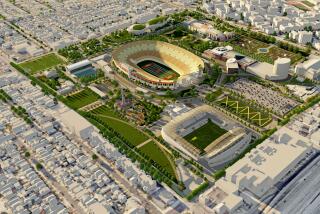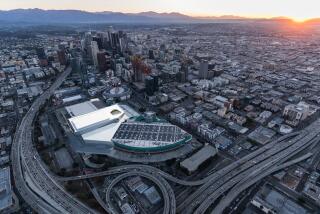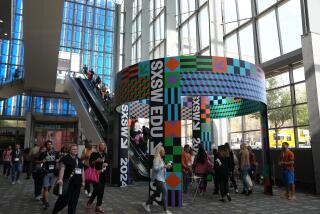Whole New Town Being Created : Seville Prepares for Expo ’92
- Share via
SEVILLE, Spain — Beneath the cobblestone Old World grace of Seville, massive changes are bursting to life.
The historic town, where Christopher Columbus made his home between trips to explore the New World, is preparing to throw a huge party to which the whole world is invited.
The party is the Universal Exhibition Seville 1992, and while it is still 2 1/2 years away, the extensive preparations are already making their mark on Seville’s ancient face.
To host Expo ‘92, organizers, backed by the central government, are creating a brand new town on the island of La Cartuja just across the Guadalquivir River from Seville.
With the help of $7 billion in government investments and other funds, developers are expanding and constructing new motor ways and bridges, building airport extensions, transplanting the city’s railway stations and even redirecting the course of the river to accommodate the onslaught of visitors expected to be drawn to the Expo,.
Once the 538-acre site on La Cartuja is fully transformed into the Expo showcase, it will have the energy and service needs of a mid-size town, developers said.
Spanning six months and celebrating “The Age of Discoveries” theme, the Expo is expected to attract about 210,000 people a day to its scores of pavilions, 16 entertainment areas, 96 restaurants, 51 shops, gardens and other facilities. Expo opens April 20, 1992 and will close Oct. 12, 1992.
If that seems to be a lot of trouble to go through, even for one long world party, Expo officials are eager to present a different view.
“This is the biggest thing that has happened to our city probably since the Discovery of Columbus,” said Expo’s international press officer Javier de la Puerta.
The ’92 Expo, held in the 500th anniversary year of Columbus’ discovery of America, coincides with other world events in Spain: the 1992 summer Olympics Games in Barcelona, Spain completes its six-year integration into the European Economic Community and Madrid will be the European Cultural Capital for the year.
Expo is being held during the first year of the European Common Market, a prospect that organizers hope to use to full advantage by catapulting Spain, which currently has the highest rate of economic growth in Europe, into the spotlight.
“This will be something like the opening party of the single market,” de la Puerta said as he accompanied a reporter on a recent tour of the Expo site.” Most countries think of Expo as the Sunday showcase for the Monday market (the EC).”
So far, 101 countries and 19 international organizations have agreed to participate in Expo, which will feature an Avenue of Europe containing the pavilions of the 12 EC communities, the European Parliament. They are hoping to attract 120 countries in all, de la Puerta said.
“It’s a whole complicated diplomatic exercise, everyone wants to have the best site, near the water,” de la Puerta said, adding that Expo developers have the power to intervene if any country’s pavilion is not completed on time.
Sixteen private sponsors and corporate participants from three continents have already contributed $250 million towards the financing of Expo, de la Puerta said.
Already the flags of participating nations are flying over the Expo site, where bulldozers and scores of construction workers are creating an immense lake and paving the way for the future pavilions.
Expo, the first universal exhibition of its kind to be held since the last one in Brussels in 1958, will also be the first to be televised, organizers said.
Marketing strategists and organizers are well-versed in even the tiniest of Expo details and eager to point out the source of their enthusiasm and hopes for the project.
“Expo is the last and most important event before the end of this century, and a unique, fantastic show window for all advanced technologies,” said Carlos Garces, president of Telemundi Spain, which is responsible for marketing the Expo.
To ensure that the hot Spanish sun does not deter visitors from enjoying the Expo, developers have created a high-tech, computer-controlled climate control system designed to keep everyone cool. Fountains, elaborate vegetation and latticework will add shade and keep cool air circulating through the walkways of Expo.
A continuous sheet of running water beneath many of the white pavements will also help keep temperatures comfortable, organizers said.
The climate control system will be used in Expo’s main theatre, along its avenues, squares, and in restaurants and cafes.
Beneath La Cartuja, a network of fiber optic cables is being laid to carry the voice, data and television signals that the event is expected to generate. After Expo closes, the installations will remain to service the university faculties, research institutes and laboratories that have already committed to occupying the site.
The Expo will enable Seville to get its first opera house, and visitors will also be able to see bullfights and visit the numerous elegant blue-tiled buildings and palm tree-lined avenues that are the legacy of the city’s 1929 exhibition.
But unlike the previous Expo, which was not backed by the government and left the city with a huge fiscal deficit, organizers said they have in place a marketing system that will break all records.
Officials at Burson-Marsteller Spain, which is serving as communications consultants for Expo, said the exhibition’s biggest selling point is the site itself.
“If you try to talk to people abstractly about it, its difficult for them to be interested,” said communications consultant Chris Fisher, a British national working at Expo. “But then they come here and quickly get excited.”
More to Read
Sign up for The Wild
We’ll help you find the best places to hike, bike and run, as well as the perfect silent spots for meditation and yoga.
You may occasionally receive promotional content from the Los Angeles Times.






